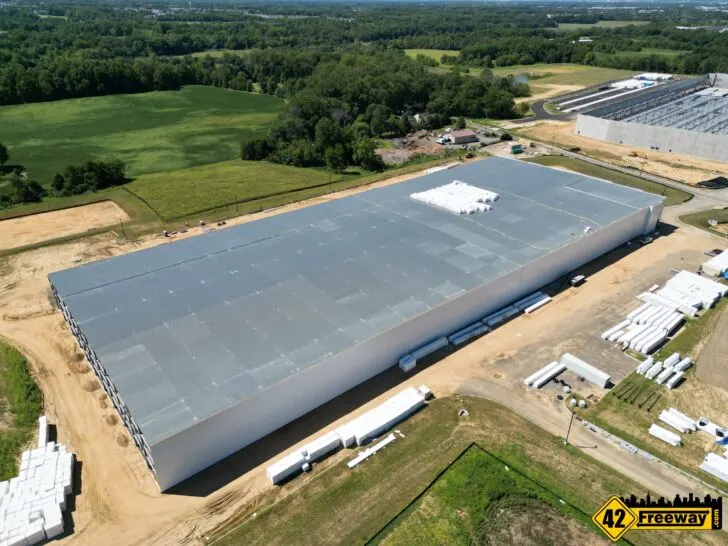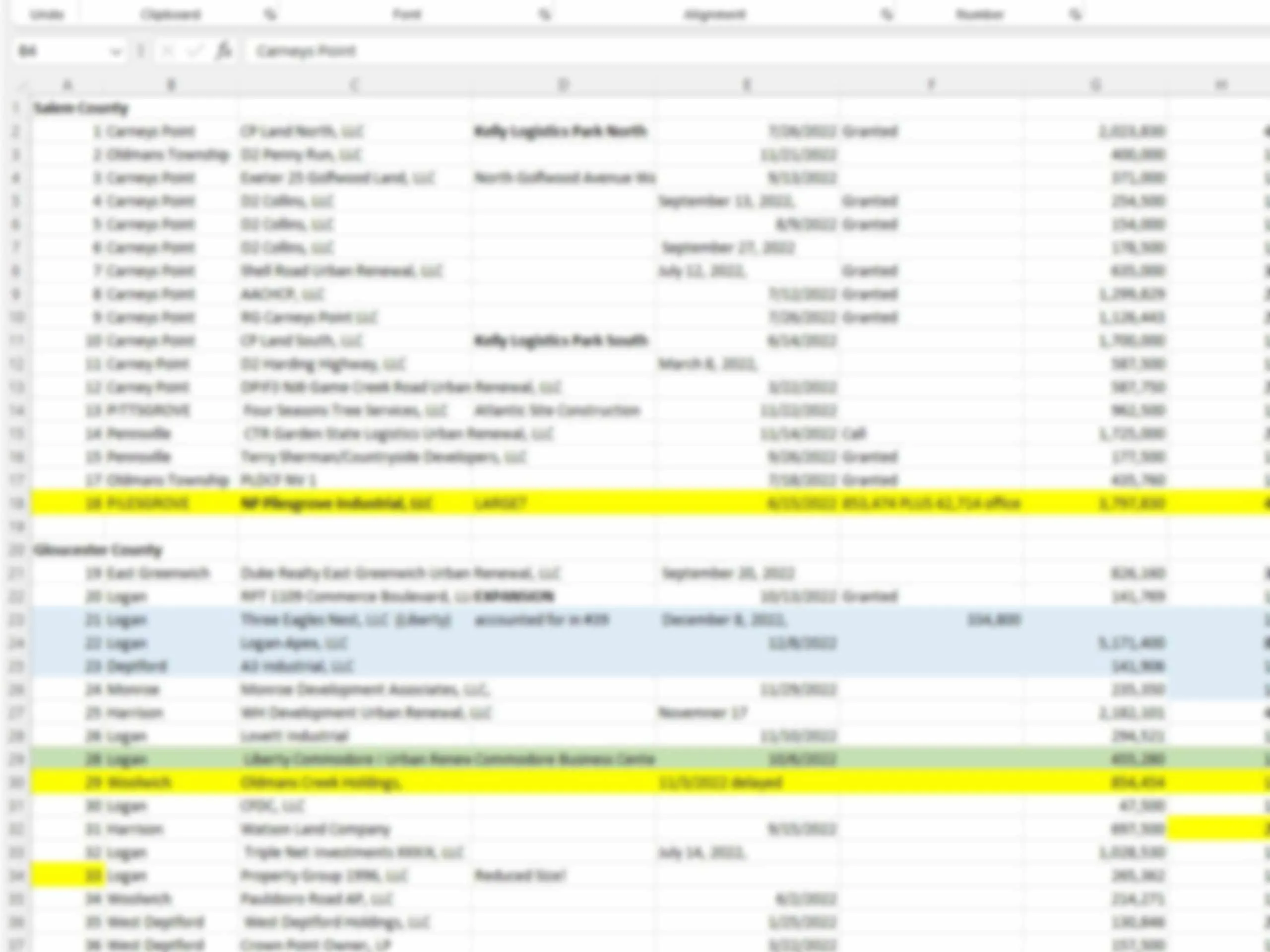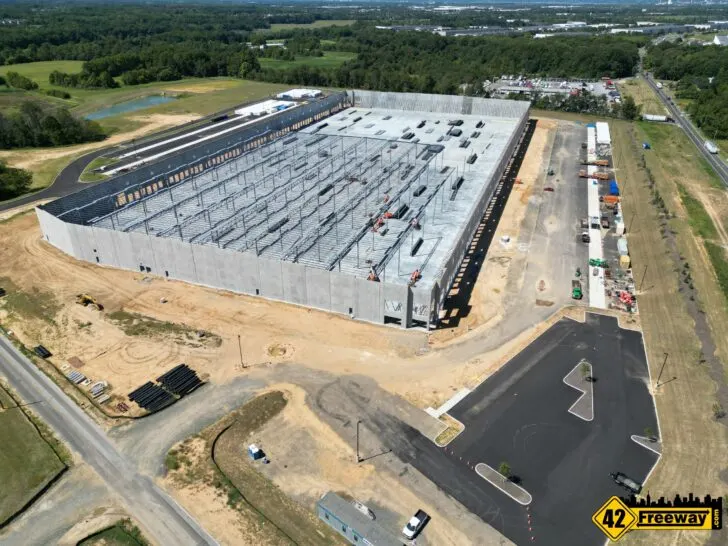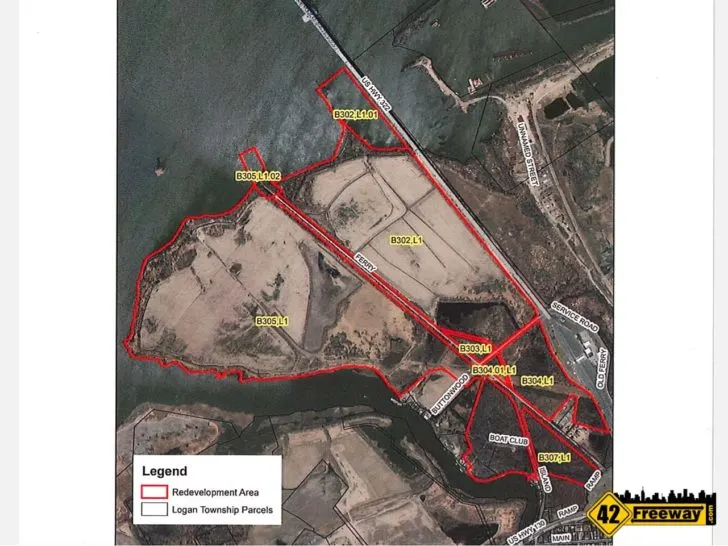We are all aware of the growing warehouse presence taking over South Jersey but I don’t think anyone would expect the numbers I put together for warehouse projects proposed in the rural New Jersey farmland counties of Salem and Gloucester.
In a many hours long, mostly manual search and collation through planning/zoning notices for the last 12 months, I’ve put together some numbers that go beyond surprising.
The numbers don’t mean all are approved. Some are still going through the process. But I can say that very few, if any were denied based on the subsequent approval notices that were published.
People share upset comments at the 42Freeway page when I post about one warehouse. What about the wildlife?! What about the traffic? What about the pollution?
Well what about if it’s 70 warehouses? What if its 30 million square feet?
And where do all of the workers come from? How long does it take to teach a cow to operate a forklift?
Keep reading for more details and Mark’s “hmmm he makes a point” commentary! ha!
By the way, 31 million square feet is the equivalent of 540 football fields. Ouch.
Consider this Part One of my analysis… more data to come. But keep scrolling and reading.

Salem and Gloucester County Planning/Zoning Warehouse projects: 12 Months
Again this was a manual effort but using a digital archive, so it may not be 100% accurate but absolutely at the “ball on the green” accuracy.
- 31 Million: Total Warehouse Square Footage
- 70: Total number of Warehouse Buildings
In a person’s lifetime this would be a shockingly large number of projects for their small local rural region.
But this is just one year. One year of distinct projects that were presented to the town planning or zoning boards in a 12 month span…. for just two mostly rural counties.

If developed, these projects will literally change the landscape of rural South Jersey along Route 295 and the New Jersey turnpike.
I always like to point out to people when they complain about development that New Jersey’s Pinelands is the largest open space on the Eastern Seaboard. “We really are the Garden State!”
But even with the Pinelands, can we still call ourselves the Garden State?
What we are seeing right now is really tough to believe we’ve gotten here without even realizing it was happening.
And this is after we’ve already seen significant warehouse development!
Honestly, I wonder if the developers and Corporations realize how much development has been approved. How much competition there is.
Is there magically now that much new need for warehouses? And who is going to run these warehouses?
More thoughts on the numbers. Keep on reading!

Can You Teach a Cow to Operate a Forklift?
I 100% understand why the South Jersey corridor along Routes 295 and the New Jersey Turnpike has gotten the attention of Warehouse Developers.
Ease of Access To Major Metro Areas
The small state of New Jersey is located right in the middle of one of the Country’s largest population areas. Philadelphia, New York, Baltimore and even down to D.C are a close commute for trucks to get to consumers and businesses.
The areas I am focused on in this article are along the very well traveled US Route 295, the New Jersey Turnpike, and have a direct link to Philadelphia via the Commodore Barry Bridge.
If you consider just the U.S Metropolitan statistical areas of New York-Newark-Jersey City, NY-NJ-PA… that is over 20 million people!
And South Jersey is right in the thick of it.
Low Population in deep South Jersey. More Land, Less Resistance
While it would be great to develop a warehouse in the middle of Manhattan where large population (customers) are, that’s obviously a non-starter. Densely populated and expensive.
Even though North Jersey is a great location and yes they already have a ton of warehouses up there… land costs are very high in the North Jersey economy than South Jersey, and it’s already MUCH more densely developed along the major highways.
For some strange reason, while the traffic on the Turnpike and Route 295 is jammed as it buzzes by, it really didn’t equal towards much development south of West Deptford other than a few large Delaware River facilties.
Sure the suburban folks have been heading south into communities like East Greenwich and Woolwich….folks wanting larger properties and cheaper prices…
But then everyone gets into their cars and drives somewhere else to work.
Most of the land below West Deptford has remained farmland.
While 200 people are protesting warehouses wedged into the already densely populated areas around Gloucester Township…
… down in the farm land areas, not only do you get large amounts of acreage to develop on, it seems in many of these more rural locations the opposition is less? Not to say the communities in Mullica Hill or Pilesgrove haven’t rallied to show displeasure at certain projects… but there have been a LOT of developments in a year and not as much outcry across the board. Well just my perspective.
And the towns that have been struggling to attract rateables are looking at the warehouses like they’ve found the pot of gold and the end of the rainbow.
Large and expensive buildings paying big tax bills and adding no kids to the expensive school districts.
Cheap Land, Cheap Taxes
The prices are going up quickly in the upcoming South Jersey warehouse belt.
A recent Philadelphia Inquirer article quotes realtor Jeff Lucas of Rose Commercial as saying the value of South Jersey industrial land has increased five-fold… in just five years.
But it’s still cheaper than North Jersey, and just as convenient for moving merchandise on the major roads.
For the last few years developers have been scouring Google satellite maps looking for the next great opportunity. That piece of prime untouched land close to the exit of a major road.
Farmers don’t have to look to sell their land. The developers are finding them.
And there is a lot of land in South Jersey along Rt 295. But it’s going fast.
People always ask me when a warehouse project is proposed “Who is it? Is it Amazon?”
Well I feel that most of the time the project is going to Planning review without a company signed on. As I stated with my Google maps depiction, developers are just constantly looking for that next development deal.
And no… Amazon is NOT building 70 warehouses in New Jersey. ha
I’ll add that with so few homes and schools in these very rural South Jersey towns, the tax rate can be less expensive than building in more populated area.
Logan Township has been a key warehouse area for decades, and is still a big player in the new wave of warehouse developments.
And it is no secret Logan has one of the lowest tax rates in the State. Lots of large buildings paying taxes when the town has minimal expenses due to lower resident population. It means a low tax rate for everyone in town.
Other town leaders hope that tax ratable logic works in their town.

So Finally, Let’s Talk Workers!
The Salem County portion of my list amounts to 16 million square feet of new warehouse space,
How many workers does that require?
Quickly its important to realize that different warehouse uses need different amounts of employees.
E-Commerce warehouses have increased the need for the number of workers per square foot,
A lower touch “We move pallets of boxes around on forklifts and have a couple trucks come in a day” warehouse might only need a few dozen workers for their 450,000 sq ft facility.
But an e-commerce direct-to-consumer Amazon style warehouse is very “high touch”. A large diverse inventory. Large numbers of orders requiring pickers to break open boxes and repackage because the person ordered 2 and they are shipped as 12 in a box.
It all means more employees to receive product, put it away on shelves, pick orders from shelves, pack and ship. Plus trucks!
So how do we turn 16 million square feet into number of workers?
Let’s go to the experts. Amazon.
Amazon offer us a nice marketing page on their warehouse operations, and for sortable fulfillment centers (like I described above) they say an 800,000 sq ft facility will need 1,500 employees
Now its time for triton math.
16 million (for Salem County) divided by 800,000 (in the Amazon example) = 20.
Basically the 16 million sq ft of warehouses proposed for rural Salem County are the equivalent of 20 Amazon warehouses.
So if we take the 1,500 employee number and multiply by 20…
That means Salem County will need at MAX, 30,000 new warehouse workers.
(Btw No, I am not saying 20 Amazon warehouse are coming. Its stated just for comparison sake. I absolutely know someone will message me on this “hey did you here that Amazon is building…”)
Here’s the kicker.
THE ENTIRE POPULATION OF SALEM COUNTY IS ONLY 65,000! That’s every adult, every child, every retired person, every disabled person. Everyone.
How do you fill 30,000 future jobs from a population of 65,000?
It gets better because not everyone can work! The Saint Louis Fed economic data lists the Salem County civilian labor force at 30,386.
The entire current workforce in Salem County equals the number of potential NEW workers needed!
I’m not talking those who are unemployed currently. I mean that if you added up the number of every single job in Salem County today (restaurant, retail, police, government)… that number is the same as the potential number of people needed to fill the upcoming Salem County warehouse jobs.
And it still gets worse!
Because for this example I only talked about the Salem County warehouses… there is still another 15 million square feet of rural located warehouses in Gloucester County!
That’s another 30,000 employees!

We’ll Need Our Own Oak Ridge
When the United States started the Manhattan Project… to develop the first nuclear weapon… they chose an area in Tennessee to set up the labs and manufacturing.
What was untouched nature and farmland in Tennessee was chosen in 1942 to become the center of the nuclear age.
The US Government new it would take an enormous amount of people to harness nuclear power. Scientists, workers.. and then school teachers and police.
It was realized the project would need a city.
What was thought to be housing for 13,000 residents quickly turned into housing for 75,000 people in just a few short years.
So back to our little Salem County and lower Gloucester County.
Do we expect 30,000 workers to drive 40 minutes away to work their warehouse jobs? Won’t many want to live closer by?
And the potential need for 30,000 workers doesn’t mean that they all show up in lower South Jersey without families. Not everyone is going to be single.
They are are going to to have spouses and kids. Then those families will needed to shop and eat, so that’s more workers.
And housing. Lots of housing. Plus roads and infrastructure.
Does anyone think of these problems? As each individual project is approved who is looking over the top of everything to say “hmmm could this cause us problems down the road?”
I mean I know I am going overboard a bit on this. But things just don’t add up for me.
All that being said I’ll ad that most of those warehouses never get built.
There just cant be that much demand. Plus interest rates are high and the economy is getting low.
An approval doesn’t mean it every gets built.
Heck, I still get messages asking when the IHOP restaurant in Deptford that was approved about 6 years ago will be built!
Approvals don’t mean they get developed.
My Warehouse Data – More to Come!
I have a lot more to share on my data, and additional break downs.
It is all in a spreadsheet broken out by town and project, with developer name, square footage, locations.
I’d like to review it further… dice it up some more.. and may present some deeper looks into the warehouses. Will need some more time to fill in the gaps in the data.
As an example, Carney’s Point has been quietly approving a huge amount of warehouses. We all had no idea.
And while my goal is to help the public with information (which I will), I don’t want to just lay out a full breadcrumb trail to stories for my media competition. ha!
Ironically the total project count I have for these warehouse projects is 42.
Well here are some extra summary numbers:
- Carney’s Point: 11 projects. 19 warehouses
- Logan Twp: 12 projects. 19 warehouses

